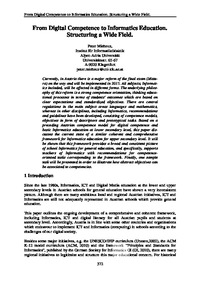From Digital Competence to Informatics EducationStructuring a Wide Field
|
 |
 Diese Seite wurde seit 12 Jahren inhaltlich nicht mehr aktualisiert.
Unter Umständen ist sie nicht mehr aktuell.
Diese Seite wurde seit 12 Jahren inhaltlich nicht mehr aktualisiert.
Unter Umständen ist sie nicht mehr aktuell.
 Zusammenfassungen
Zusammenfassungen
 Currently, in Austria there is a major reform of the final exam (Matura) on the way and will be implemented in 2015. All subjects, Informatics included, will be affected in different forms. The underlying philosophy of this reform is a strong competence orientation, thinking educational processes in terms of students’ outcomes which are based on clear expectations and standardized objectives. There are central regulations in the main subject areas languages and mathematics, whereas in other disciplines, including Informatics, recommendations and guidelines have been developed, consisting of competence models, objectives in form of descriptors and prototypical tasks. Based on a preceding Austrian competence model for digital competence and basic Informatics education at lower secondary level, this paper discusses the current state of a similar coherent and comprehensive framework for Informatics education for upper secondary level. It will be shown that this framework provides a broad and consistent picture of school Informatics for general education, and specifically, supports teachers of Informatics with recommendations for competenceoriented tasks corresponding to the framework. Finally, one sample task will be presented in order to illustrate how abstract objectives can be associated to competencies.
Currently, in Austria there is a major reform of the final exam (Matura) on the way and will be implemented in 2015. All subjects, Informatics included, will be affected in different forms. The underlying philosophy of this reform is a strong competence orientation, thinking educational processes in terms of students’ outcomes which are based on clear expectations and standardized objectives. There are central regulations in the main subject areas languages and mathematics, whereas in other disciplines, including Informatics, recommendations and guidelines have been developed, consisting of competence models, objectives in form of descriptors and prototypical tasks. Based on a preceding Austrian competence model for digital competence and basic Informatics education at lower secondary level, this paper discusses the current state of a similar coherent and comprehensive framework for Informatics education for upper secondary level. It will be shown that this framework provides a broad and consistent picture of school Informatics for general education, and specifically, supports teachers of Informatics with recommendations for competenceoriented tasks corresponding to the framework. Finally, one sample task will be presented in order to illustrate how abstract objectives can be associated to competencies. Dieses Konferenz-Paper erwähnt ...
Dieses Konferenz-Paper erwähnt ...
 Personen KB IB clear | B. S. Bloom , Peter Micheuz , Franz E. Weinert | ||||||||||||||||||||||||||||||||||||
 Begriffe KB IB clear | Informatikcomputer science , Informatik-Unterricht (Fachinformatik)Computer Science Education , Kompetenzcompetence , ÖsterreichAustria | ||||||||||||||||||||||||||||||||||||
 Bücher |
| ||||||||||||||||||||||||||||||||||||
 Texte |
|
 Dieses Konferenz-Paper erwähnt vermutlich nicht ...
Dieses Konferenz-Paper erwähnt vermutlich nicht ... 
 Nicht erwähnte Begriffe | Informatik-Didaktik, Informatikunterricht in der Schule |
 Tagcloud
Tagcloud
 Zitationsgraph
Zitationsgraph
 Zitationsgraph (Beta-Test mit vis.js)
Zitationsgraph (Beta-Test mit vis.js)
 Volltext dieses Dokuments
Volltext dieses Dokuments
 |  From Digital Competence to Informatics Education: Artikel als Volltext ( From Digital Competence to Informatics Education: Artikel als Volltext ( : :  , 382 kByte; , 382 kByte;  : :  2021-03-21) 2021-03-21) |
 Anderswo suchen
Anderswo suchen 
 Beat und dieses Konferenz-Paper
Beat und dieses Konferenz-Paper
Beat hat Dieses Konferenz-Paper während seiner Zeit am Institut für Medien und Schule (IMS) ins Biblionetz aufgenommen. Er hat Dieses Konferenz-Paper einmalig erfasst und bisher nicht mehr bearbeitet. Beat besitzt kein physisches, aber ein digitales Exemplar. Eine digitale Version ist auf dem Internet verfügbar (s.o.). Aufgrund der wenigen Einträge im Biblionetz scheint er es nicht wirklich gelesen zu haben. Es gibt bisher auch nur wenige Objekte im Biblionetz, die dieses Werk zitieren.










 Biblionetz-History
Biblionetz-History